Applying Theoretical Models to NHS: Leadership, Training, and Talent
VerifiedAdded on 2023/01/11
|10
|3188
|20
Report
AI Summary
This report provides an in-depth analysis of the NHS, a publicly funded healthcare system in the UK, focusing on people management. The report examines the application of theoretical models to leadership, management, training, and talent management within the NHS context, addressing staff shortages and retention issues. It highlights the importance of situational leadership, off-the-job training, and proactive talent management strategies. The report also analyzes the role and priorities of NHS management and the HR function in supporting staff and outlines the internal and external influences impacting these areas. Finally, the report offers recommendations to improve staff retention, improve patient care, and achieve the organization's objectives.

Introduction to People
Management
(NHS Case Study)
Management
(NHS Case Study)
Paraphrase This Document
Need a fresh take? Get an instant paraphrase of this document with our AI Paraphraser
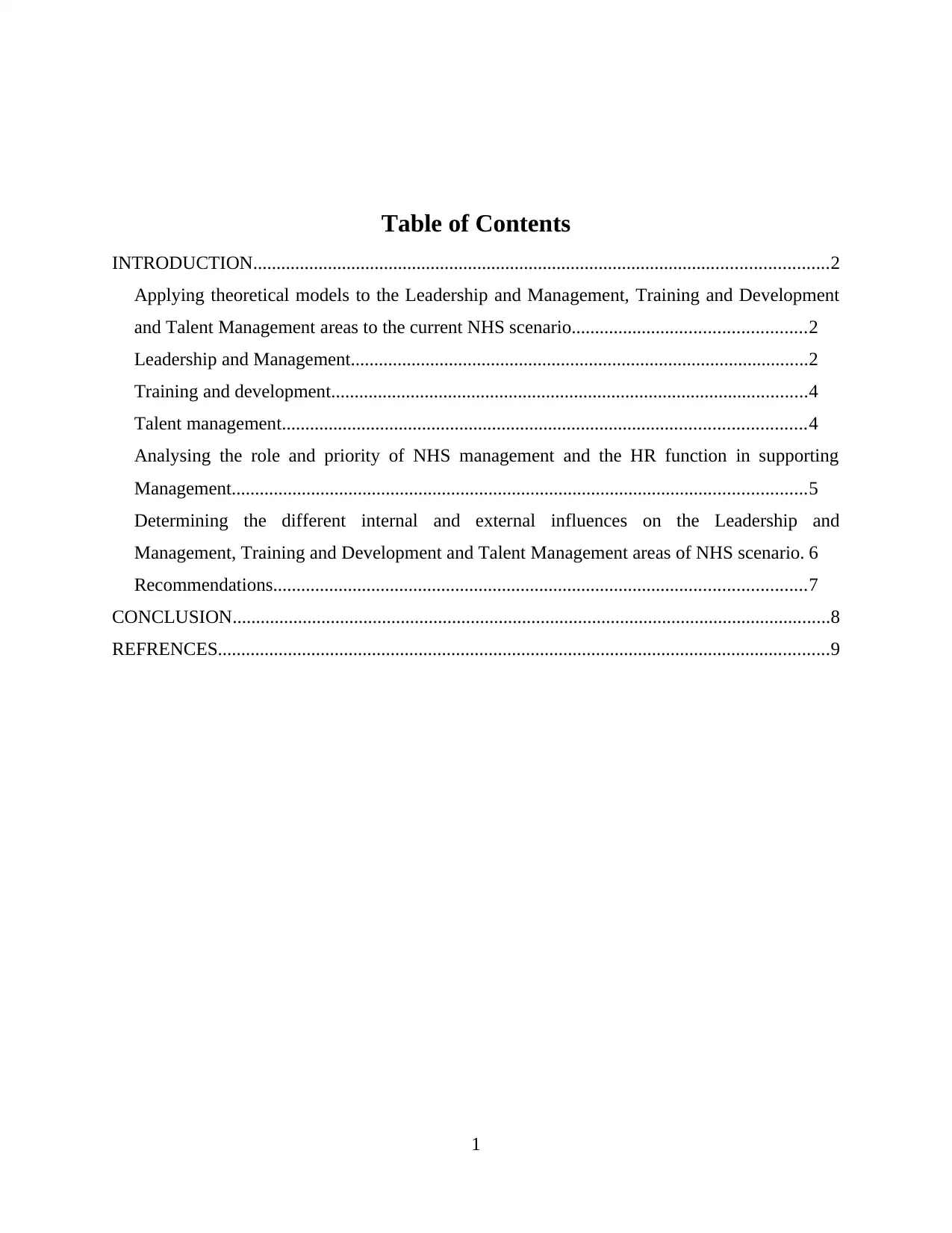
Table of Contents
INTRODUCTION...........................................................................................................................2
Applying theoretical models to the Leadership and Management, Training and Development
and Talent Management areas to the current NHS scenario..................................................2
Leadership and Management..................................................................................................2
Training and development......................................................................................................4
Talent management................................................................................................................4
Analysing the role and priority of NHS management and the HR function in supporting
Management...........................................................................................................................5
Determining the different internal and external influences on the Leadership and
Management, Training and Development and Talent Management areas of NHS scenario. 6
Recommendations..................................................................................................................7
CONCLUSION................................................................................................................................8
REFRENCES...................................................................................................................................9
1
INTRODUCTION...........................................................................................................................2
Applying theoretical models to the Leadership and Management, Training and Development
and Talent Management areas to the current NHS scenario..................................................2
Leadership and Management..................................................................................................2
Training and development......................................................................................................4
Talent management................................................................................................................4
Analysing the role and priority of NHS management and the HR function in supporting
Management...........................................................................................................................5
Determining the different internal and external influences on the Leadership and
Management, Training and Development and Talent Management areas of NHS scenario. 6
Recommendations..................................................................................................................7
CONCLUSION................................................................................................................................8
REFRENCES...................................................................................................................................9
1
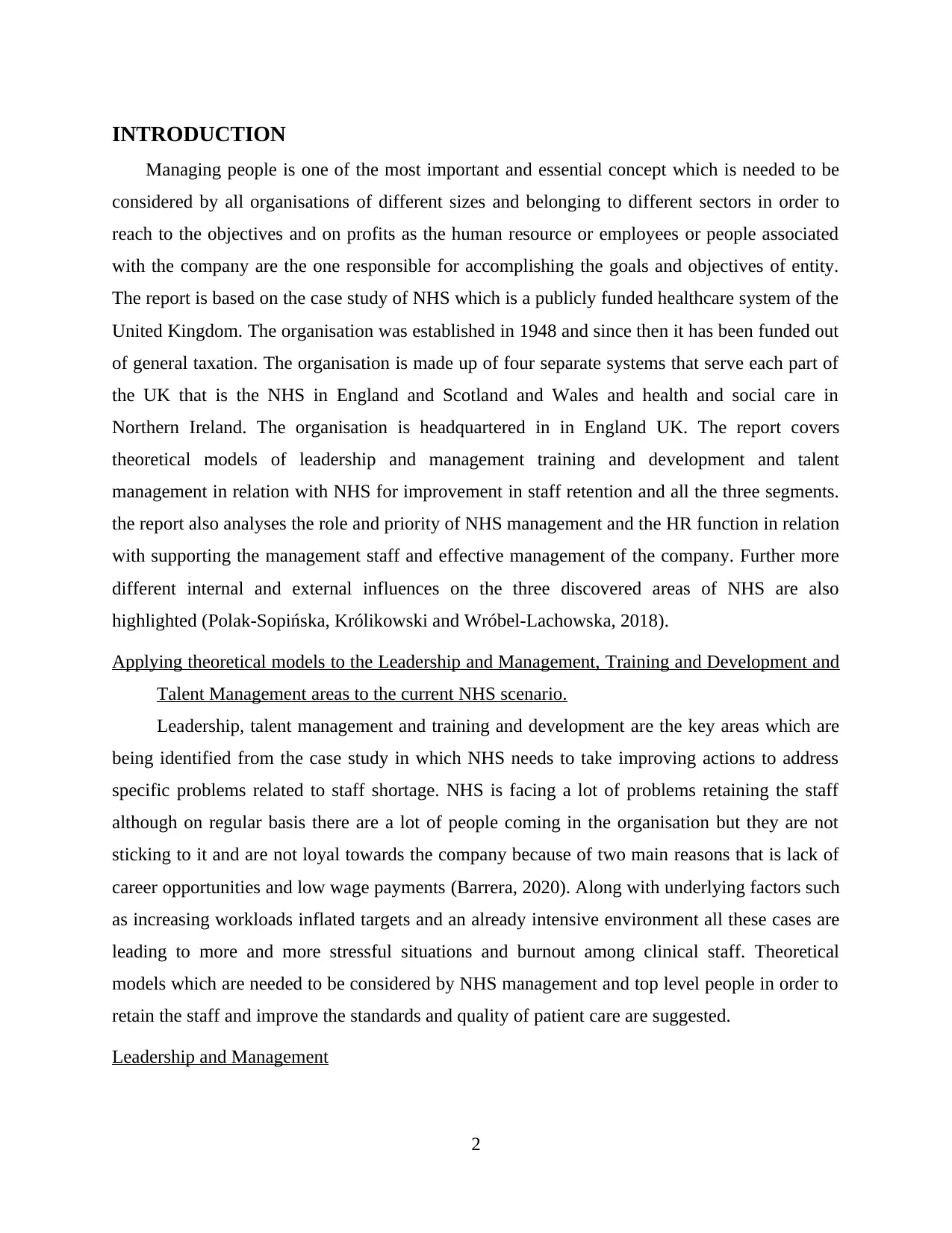
INTRODUCTION
Managing people is one of the most important and essential concept which is needed to be
considered by all organisations of different sizes and belonging to different sectors in order to
reach to the objectives and on profits as the human resource or employees or people associated
with the company are the one responsible for accomplishing the goals and objectives of entity.
The report is based on the case study of NHS which is a publicly funded healthcare system of the
United Kingdom. The organisation was established in 1948 and since then it has been funded out
of general taxation. The organisation is made up of four separate systems that serve each part of
the UK that is the NHS in England and Scotland and Wales and health and social care in
Northern Ireland. The organisation is headquartered in in England UK. The report covers
theoretical models of leadership and management training and development and talent
management in relation with NHS for improvement in staff retention and all the three segments.
the report also analyses the role and priority of NHS management and the HR function in relation
with supporting the management staff and effective management of the company. Further more
different internal and external influences on the three discovered areas of NHS are also
highlighted (Polak-Sopińska, Królikowski and Wróbel-Lachowska, 2018).
Applying theoretical models to the Leadership and Management, Training and Development and
Talent Management areas to the current NHS scenario.
Leadership, talent management and training and development are the key areas which are
being identified from the case study in which NHS needs to take improving actions to address
specific problems related to staff shortage. NHS is facing a lot of problems retaining the staff
although on regular basis there are a lot of people coming in the organisation but they are not
sticking to it and are not loyal towards the company because of two main reasons that is lack of
career opportunities and low wage payments (Barrera, 2020). Along with underlying factors such
as increasing workloads inflated targets and an already intensive environment all these cases are
leading to more and more stressful situations and burnout among clinical staff. Theoretical
models which are needed to be considered by NHS management and top level people in order to
retain the staff and improve the standards and quality of patient care are suggested.
Leadership and Management
2
Managing people is one of the most important and essential concept which is needed to be
considered by all organisations of different sizes and belonging to different sectors in order to
reach to the objectives and on profits as the human resource or employees or people associated
with the company are the one responsible for accomplishing the goals and objectives of entity.
The report is based on the case study of NHS which is a publicly funded healthcare system of the
United Kingdom. The organisation was established in 1948 and since then it has been funded out
of general taxation. The organisation is made up of four separate systems that serve each part of
the UK that is the NHS in England and Scotland and Wales and health and social care in
Northern Ireland. The organisation is headquartered in in England UK. The report covers
theoretical models of leadership and management training and development and talent
management in relation with NHS for improvement in staff retention and all the three segments.
the report also analyses the role and priority of NHS management and the HR function in relation
with supporting the management staff and effective management of the company. Further more
different internal and external influences on the three discovered areas of NHS are also
highlighted (Polak-Sopińska, Królikowski and Wróbel-Lachowska, 2018).
Applying theoretical models to the Leadership and Management, Training and Development and
Talent Management areas to the current NHS scenario.
Leadership, talent management and training and development are the key areas which are
being identified from the case study in which NHS needs to take improving actions to address
specific problems related to staff shortage. NHS is facing a lot of problems retaining the staff
although on regular basis there are a lot of people coming in the organisation but they are not
sticking to it and are not loyal towards the company because of two main reasons that is lack of
career opportunities and low wage payments (Barrera, 2020). Along with underlying factors such
as increasing workloads inflated targets and an already intensive environment all these cases are
leading to more and more stressful situations and burnout among clinical staff. Theoretical
models which are needed to be considered by NHS management and top level people in order to
retain the staff and improve the standards and quality of patient care are suggested.
Leadership and Management
2
⊘ This is a preview!⊘
Do you want full access?
Subscribe today to unlock all pages.

Trusted by 1+ million students worldwide
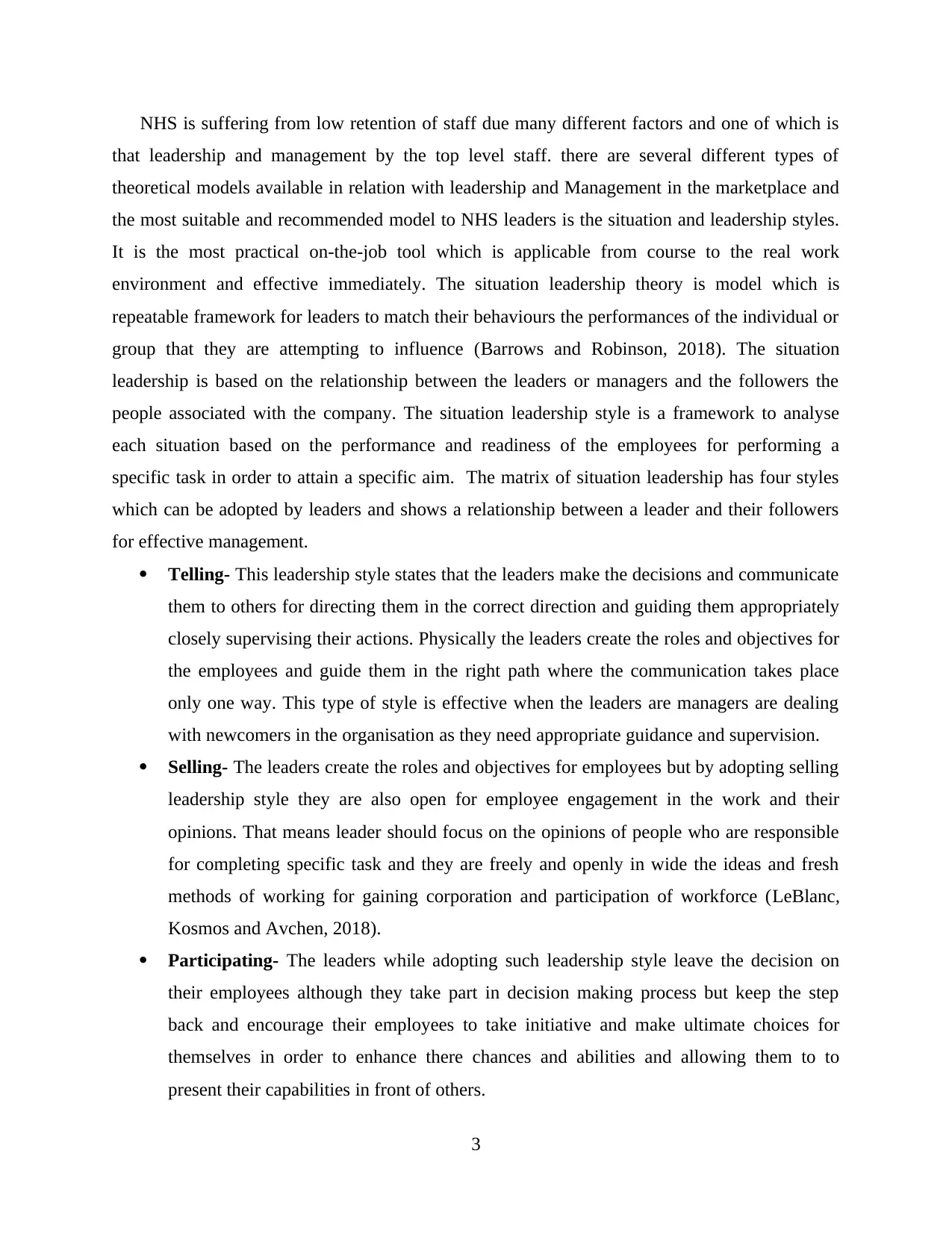
NHS is suffering from low retention of staff due many different factors and one of which is
that leadership and management by the top level staff. there are several different types of
theoretical models available in relation with leadership and Management in the marketplace and
the most suitable and recommended model to NHS leaders is the situation and leadership styles.
It is the most practical on-the-job tool which is applicable from course to the real work
environment and effective immediately. The situation leadership theory is model which is
repeatable framework for leaders to match their behaviours the performances of the individual or
group that they are attempting to influence (Barrows and Robinson, 2018). The situation
leadership is based on the relationship between the leaders or managers and the followers the
people associated with the company. The situation leadership style is a framework to analyse
each situation based on the performance and readiness of the employees for performing a
specific task in order to attain a specific aim. The matrix of situation leadership has four styles
which can be adopted by leaders and shows a relationship between a leader and their followers
for effective management.
Telling- This leadership style states that the leaders make the decisions and communicate
them to others for directing them in the correct direction and guiding them appropriately
closely supervising their actions. Physically the leaders create the roles and objectives for
the employees and guide them in the right path where the communication takes place
only one way. This type of style is effective when the leaders are managers are dealing
with newcomers in the organisation as they need appropriate guidance and supervision.
Selling- The leaders create the roles and objectives for employees but by adopting selling
leadership style they are also open for employee engagement in the work and their
opinions. That means leader should focus on the opinions of people who are responsible
for completing specific task and they are freely and openly in wide the ideas and fresh
methods of working for gaining corporation and participation of workforce (LeBlanc,
Kosmos and Avchen, 2018).
Participating- The leaders while adopting such leadership style leave the decision on
their employees although they take part in decision making process but keep the step
back and encourage their employees to take initiative and make ultimate choices for
themselves in order to enhance there chances and abilities and allowing them to to
present their capabilities in front of others.
3
that leadership and management by the top level staff. there are several different types of
theoretical models available in relation with leadership and Management in the marketplace and
the most suitable and recommended model to NHS leaders is the situation and leadership styles.
It is the most practical on-the-job tool which is applicable from course to the real work
environment and effective immediately. The situation leadership theory is model which is
repeatable framework for leaders to match their behaviours the performances of the individual or
group that they are attempting to influence (Barrows and Robinson, 2018). The situation
leadership is based on the relationship between the leaders or managers and the followers the
people associated with the company. The situation leadership style is a framework to analyse
each situation based on the performance and readiness of the employees for performing a
specific task in order to attain a specific aim. The matrix of situation leadership has four styles
which can be adopted by leaders and shows a relationship between a leader and their followers
for effective management.
Telling- This leadership style states that the leaders make the decisions and communicate
them to others for directing them in the correct direction and guiding them appropriately
closely supervising their actions. Physically the leaders create the roles and objectives for
the employees and guide them in the right path where the communication takes place
only one way. This type of style is effective when the leaders are managers are dealing
with newcomers in the organisation as they need appropriate guidance and supervision.
Selling- The leaders create the roles and objectives for employees but by adopting selling
leadership style they are also open for employee engagement in the work and their
opinions. That means leader should focus on the opinions of people who are responsible
for completing specific task and they are freely and openly in wide the ideas and fresh
methods of working for gaining corporation and participation of workforce (LeBlanc,
Kosmos and Avchen, 2018).
Participating- The leaders while adopting such leadership style leave the decision on
their employees although they take part in decision making process but keep the step
back and encourage their employees to take initiative and make ultimate choices for
themselves in order to enhance there chances and abilities and allowing them to to
present their capabilities in front of others.
3
Paraphrase This Document
Need a fresh take? Get an instant paraphrase of this document with our AI Paraphraser
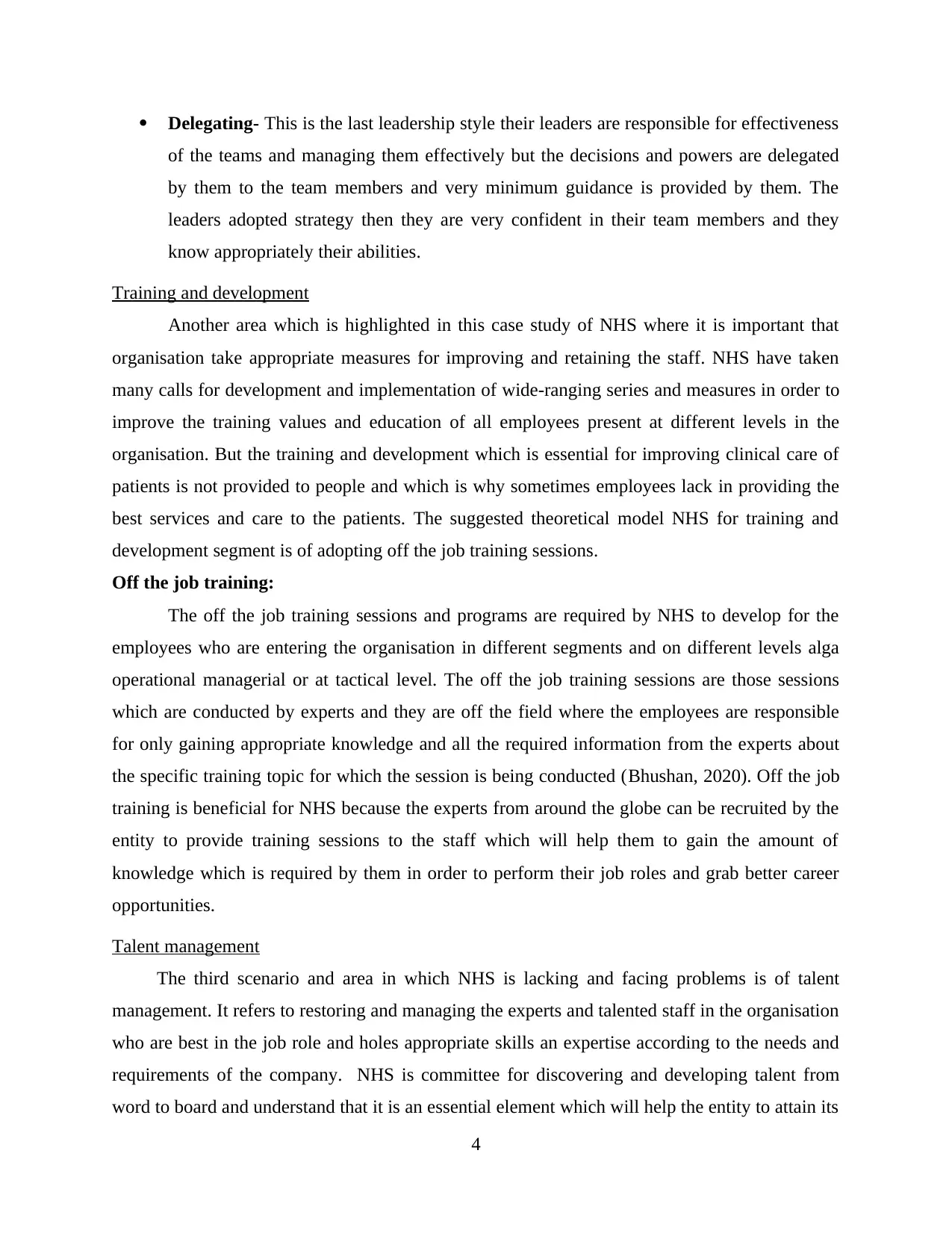
Delegating- This is the last leadership style their leaders are responsible for effectiveness
of the teams and managing them effectively but the decisions and powers are delegated
by them to the team members and very minimum guidance is provided by them. The
leaders adopted strategy then they are very confident in their team members and they
know appropriately their abilities.
Training and development
Another area which is highlighted in this case study of NHS where it is important that
organisation take appropriate measures for improving and retaining the staff. NHS have taken
many calls for development and implementation of wide-ranging series and measures in order to
improve the training values and education of all employees present at different levels in the
organisation. But the training and development which is essential for improving clinical care of
patients is not provided to people and which is why sometimes employees lack in providing the
best services and care to the patients. The suggested theoretical model NHS for training and
development segment is of adopting off the job training sessions.
Off the job training:
The off the job training sessions and programs are required by NHS to develop for the
employees who are entering the organisation in different segments and on different levels alga
operational managerial or at tactical level. The off the job training sessions are those sessions
which are conducted by experts and they are off the field where the employees are responsible
for only gaining appropriate knowledge and all the required information from the experts about
the specific training topic for which the session is being conducted (Bhushan, 2020). Off the job
training is beneficial for NHS because the experts from around the globe can be recruited by the
entity to provide training sessions to the staff which will help them to gain the amount of
knowledge which is required by them in order to perform their job roles and grab better career
opportunities.
Talent management
The third scenario and area in which NHS is lacking and facing problems is of talent
management. It refers to restoring and managing the experts and talented staff in the organisation
who are best in the job role and holes appropriate skills an expertise according to the needs and
requirements of the company. NHS is committee for discovering and developing talent from
word to board and understand that it is an essential element which will help the entity to attain its
4
of the teams and managing them effectively but the decisions and powers are delegated
by them to the team members and very minimum guidance is provided by them. The
leaders adopted strategy then they are very confident in their team members and they
know appropriately their abilities.
Training and development
Another area which is highlighted in this case study of NHS where it is important that
organisation take appropriate measures for improving and retaining the staff. NHS have taken
many calls for development and implementation of wide-ranging series and measures in order to
improve the training values and education of all employees present at different levels in the
organisation. But the training and development which is essential for improving clinical care of
patients is not provided to people and which is why sometimes employees lack in providing the
best services and care to the patients. The suggested theoretical model NHS for training and
development segment is of adopting off the job training sessions.
Off the job training:
The off the job training sessions and programs are required by NHS to develop for the
employees who are entering the organisation in different segments and on different levels alga
operational managerial or at tactical level. The off the job training sessions are those sessions
which are conducted by experts and they are off the field where the employees are responsible
for only gaining appropriate knowledge and all the required information from the experts about
the specific training topic for which the session is being conducted (Bhushan, 2020). Off the job
training is beneficial for NHS because the experts from around the globe can be recruited by the
entity to provide training sessions to the staff which will help them to gain the amount of
knowledge which is required by them in order to perform their job roles and grab better career
opportunities.
Talent management
The third scenario and area in which NHS is lacking and facing problems is of talent
management. It refers to restoring and managing the experts and talented staff in the organisation
who are best in the job role and holes appropriate skills an expertise according to the needs and
requirements of the company. NHS is committee for discovering and developing talent from
word to board and understand that it is an essential element which will help the entity to attain its
4
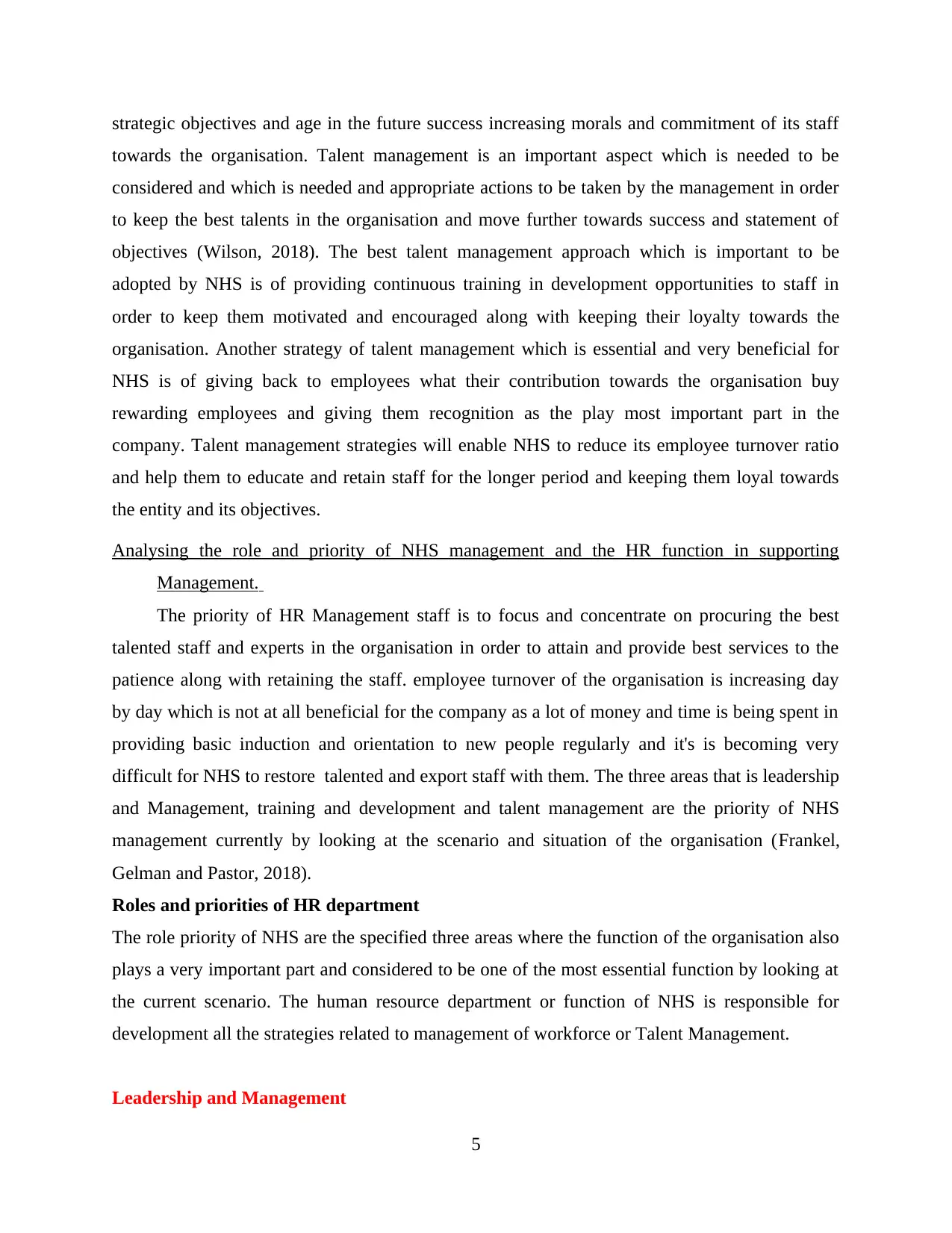
strategic objectives and age in the future success increasing morals and commitment of its staff
towards the organisation. Talent management is an important aspect which is needed to be
considered and which is needed and appropriate actions to be taken by the management in order
to keep the best talents in the organisation and move further towards success and statement of
objectives (Wilson, 2018). The best talent management approach which is important to be
adopted by NHS is of providing continuous training in development opportunities to staff in
order to keep them motivated and encouraged along with keeping their loyalty towards the
organisation. Another strategy of talent management which is essential and very beneficial for
NHS is of giving back to employees what their contribution towards the organisation buy
rewarding employees and giving them recognition as the play most important part in the
company. Talent management strategies will enable NHS to reduce its employee turnover ratio
and help them to educate and retain staff for the longer period and keeping them loyal towards
the entity and its objectives.
Analysing the role and priority of NHS management and the HR function in supporting
Management.
The priority of HR Management staff is to focus and concentrate on procuring the best
talented staff and experts in the organisation in order to attain and provide best services to the
patience along with retaining the staff. employee turnover of the organisation is increasing day
by day which is not at all beneficial for the company as a lot of money and time is being spent in
providing basic induction and orientation to new people regularly and it's is becoming very
difficult for NHS to restore talented and export staff with them. The three areas that is leadership
and Management, training and development and talent management are the priority of NHS
management currently by looking at the scenario and situation of the organisation (Frankel,
Gelman and Pastor, 2018).
Roles and priorities of HR department
The role priority of NHS are the specified three areas where the function of the organisation also
plays a very important part and considered to be one of the most essential function by looking at
the current scenario. The human resource department or function of NHS is responsible for
development all the strategies related to management of workforce or Talent Management.
Leadership and Management
5
towards the organisation. Talent management is an important aspect which is needed to be
considered and which is needed and appropriate actions to be taken by the management in order
to keep the best talents in the organisation and move further towards success and statement of
objectives (Wilson, 2018). The best talent management approach which is important to be
adopted by NHS is of providing continuous training in development opportunities to staff in
order to keep them motivated and encouraged along with keeping their loyalty towards the
organisation. Another strategy of talent management which is essential and very beneficial for
NHS is of giving back to employees what their contribution towards the organisation buy
rewarding employees and giving them recognition as the play most important part in the
company. Talent management strategies will enable NHS to reduce its employee turnover ratio
and help them to educate and retain staff for the longer period and keeping them loyal towards
the entity and its objectives.
Analysing the role and priority of NHS management and the HR function in supporting
Management.
The priority of HR Management staff is to focus and concentrate on procuring the best
talented staff and experts in the organisation in order to attain and provide best services to the
patience along with retaining the staff. employee turnover of the organisation is increasing day
by day which is not at all beneficial for the company as a lot of money and time is being spent in
providing basic induction and orientation to new people regularly and it's is becoming very
difficult for NHS to restore talented and export staff with them. The three areas that is leadership
and Management, training and development and talent management are the priority of NHS
management currently by looking at the scenario and situation of the organisation (Frankel,
Gelman and Pastor, 2018).
Roles and priorities of HR department
The role priority of NHS are the specified three areas where the function of the organisation also
plays a very important part and considered to be one of the most essential function by looking at
the current scenario. The human resource department or function of NHS is responsible for
development all the strategies related to management of workforce or Talent Management.
Leadership and Management
5
⊘ This is a preview!⊘
Do you want full access?
Subscribe today to unlock all pages.

Trusted by 1+ million students worldwide
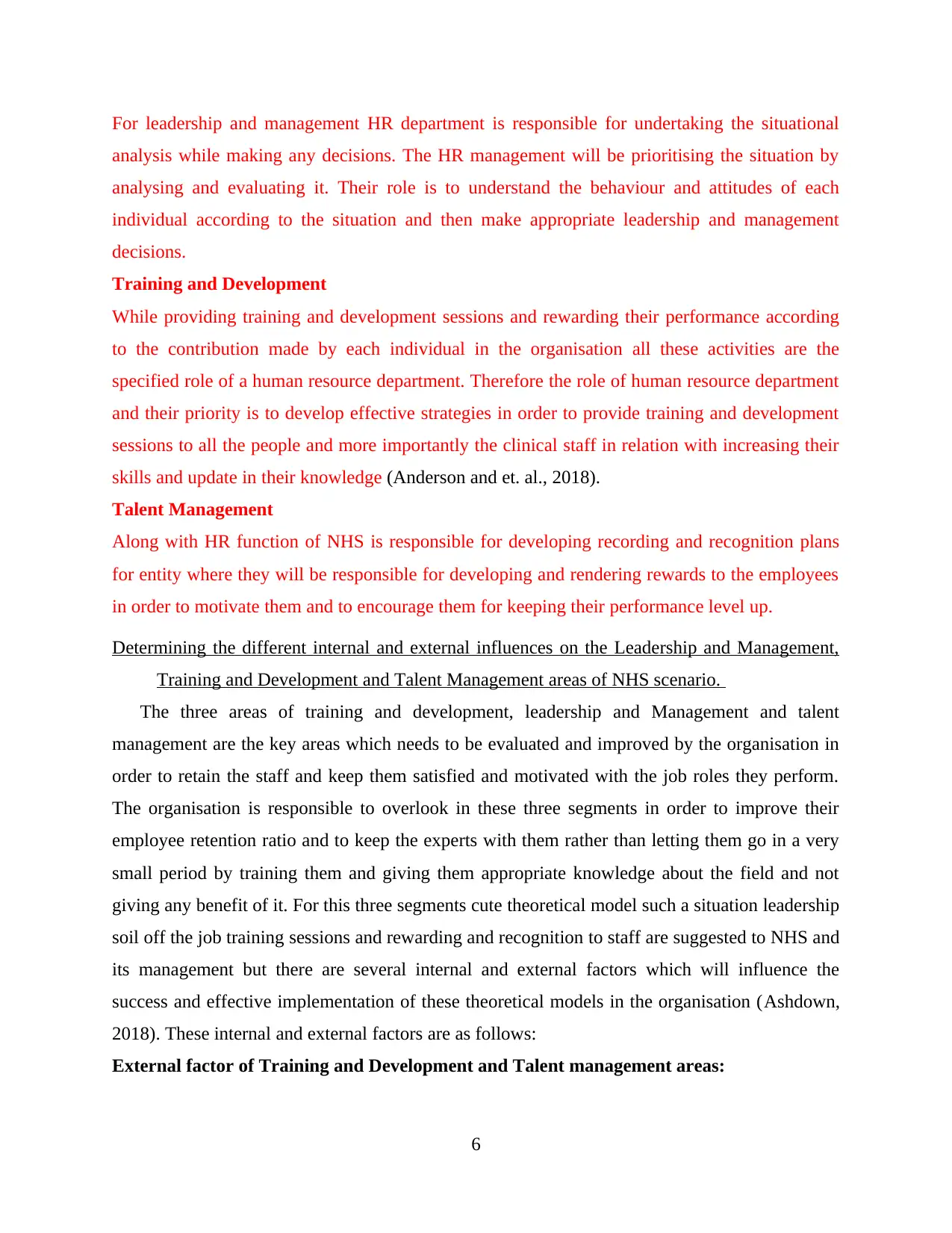
For leadership and management HR department is responsible for undertaking the situational
analysis while making any decisions. The HR management will be prioritising the situation by
analysing and evaluating it. Their role is to understand the behaviour and attitudes of each
individual according to the situation and then make appropriate leadership and management
decisions.
Training and Development
While providing training and development sessions and rewarding their performance according
to the contribution made by each individual in the organisation all these activities are the
specified role of a human resource department. Therefore the role of human resource department
and their priority is to develop effective strategies in order to provide training and development
sessions to all the people and more importantly the clinical staff in relation with increasing their
skills and update in their knowledge (Anderson and et. al., 2018).
Talent Management
Along with HR function of NHS is responsible for developing recording and recognition plans
for entity where they will be responsible for developing and rendering rewards to the employees
in order to motivate them and to encourage them for keeping their performance level up.
Determining the different internal and external influences on the Leadership and Management,
Training and Development and Talent Management areas of NHS scenario.
The three areas of training and development, leadership and Management and talent
management are the key areas which needs to be evaluated and improved by the organisation in
order to retain the staff and keep them satisfied and motivated with the job roles they perform.
The organisation is responsible to overlook in these three segments in order to improve their
employee retention ratio and to keep the experts with them rather than letting them go in a very
small period by training them and giving them appropriate knowledge about the field and not
giving any benefit of it. For this three segments cute theoretical model such a situation leadership
soil off the job training sessions and rewarding and recognition to staff are suggested to NHS and
its management but there are several internal and external factors which will influence the
success and effective implementation of these theoretical models in the organisation (Ashdown,
2018). These internal and external factors are as follows:
External factor of Training and Development and Talent management areas:
6
analysis while making any decisions. The HR management will be prioritising the situation by
analysing and evaluating it. Their role is to understand the behaviour and attitudes of each
individual according to the situation and then make appropriate leadership and management
decisions.
Training and Development
While providing training and development sessions and rewarding their performance according
to the contribution made by each individual in the organisation all these activities are the
specified role of a human resource department. Therefore the role of human resource department
and their priority is to develop effective strategies in order to provide training and development
sessions to all the people and more importantly the clinical staff in relation with increasing their
skills and update in their knowledge (Anderson and et. al., 2018).
Talent Management
Along with HR function of NHS is responsible for developing recording and recognition plans
for entity where they will be responsible for developing and rendering rewards to the employees
in order to motivate them and to encourage them for keeping their performance level up.
Determining the different internal and external influences on the Leadership and Management,
Training and Development and Talent Management areas of NHS scenario.
The three areas of training and development, leadership and Management and talent
management are the key areas which needs to be evaluated and improved by the organisation in
order to retain the staff and keep them satisfied and motivated with the job roles they perform.
The organisation is responsible to overlook in these three segments in order to improve their
employee retention ratio and to keep the experts with them rather than letting them go in a very
small period by training them and giving them appropriate knowledge about the field and not
giving any benefit of it. For this three segments cute theoretical model such a situation leadership
soil off the job training sessions and rewarding and recognition to staff are suggested to NHS and
its management but there are several internal and external factors which will influence the
success and effective implementation of these theoretical models in the organisation (Ashdown,
2018). These internal and external factors are as follows:
External factor of Training and Development and Talent management areas:
6
Paraphrase This Document
Need a fresh take? Get an instant paraphrase of this document with our AI Paraphraser
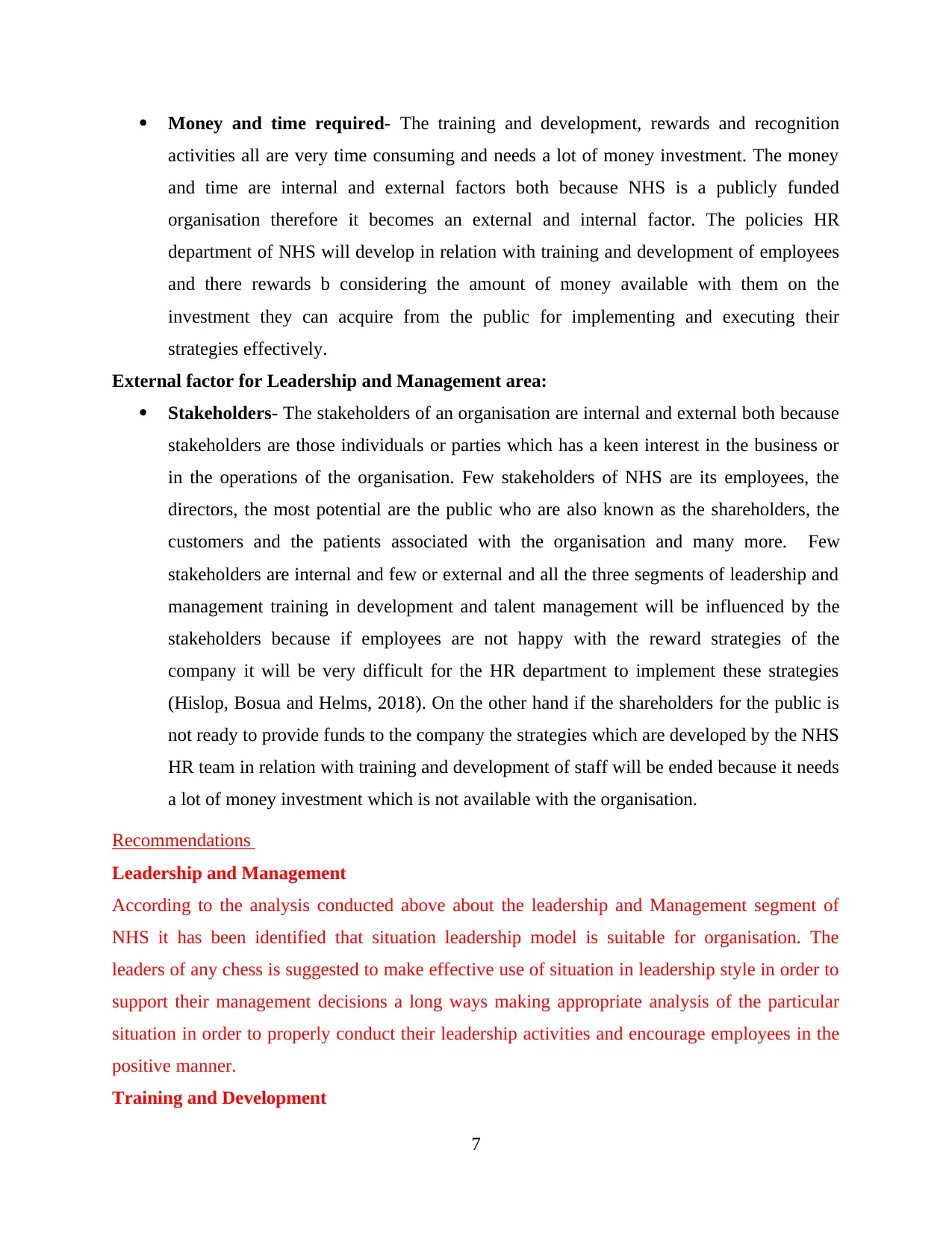
Money and time required- The training and development, rewards and recognition
activities all are very time consuming and needs a lot of money investment. The money
and time are internal and external factors both because NHS is a publicly funded
organisation therefore it becomes an external and internal factor. The policies HR
department of NHS will develop in relation with training and development of employees
and there rewards b considering the amount of money available with them on the
investment they can acquire from the public for implementing and executing their
strategies effectively.
External factor for Leadership and Management area:
Stakeholders- The stakeholders of an organisation are internal and external both because
stakeholders are those individuals or parties which has a keen interest in the business or
in the operations of the organisation. Few stakeholders of NHS are its employees, the
directors, the most potential are the public who are also known as the shareholders, the
customers and the patients associated with the organisation and many more. Few
stakeholders are internal and few or external and all the three segments of leadership and
management training in development and talent management will be influenced by the
stakeholders because if employees are not happy with the reward strategies of the
company it will be very difficult for the HR department to implement these strategies
(Hislop, Bosua and Helms, 2018). On the other hand if the shareholders for the public is
not ready to provide funds to the company the strategies which are developed by the NHS
HR team in relation with training and development of staff will be ended because it needs
a lot of money investment which is not available with the organisation.
Recommendations
Leadership and Management
According to the analysis conducted above about the leadership and Management segment of
NHS it has been identified that situation leadership model is suitable for organisation. The
leaders of any chess is suggested to make effective use of situation in leadership style in order to
support their management decisions a long ways making appropriate analysis of the particular
situation in order to properly conduct their leadership activities and encourage employees in the
positive manner.
Training and Development
7
activities all are very time consuming and needs a lot of money investment. The money
and time are internal and external factors both because NHS is a publicly funded
organisation therefore it becomes an external and internal factor. The policies HR
department of NHS will develop in relation with training and development of employees
and there rewards b considering the amount of money available with them on the
investment they can acquire from the public for implementing and executing their
strategies effectively.
External factor for Leadership and Management area:
Stakeholders- The stakeholders of an organisation are internal and external both because
stakeholders are those individuals or parties which has a keen interest in the business or
in the operations of the organisation. Few stakeholders of NHS are its employees, the
directors, the most potential are the public who are also known as the shareholders, the
customers and the patients associated with the organisation and many more. Few
stakeholders are internal and few or external and all the three segments of leadership and
management training in development and talent management will be influenced by the
stakeholders because if employees are not happy with the reward strategies of the
company it will be very difficult for the HR department to implement these strategies
(Hislop, Bosua and Helms, 2018). On the other hand if the shareholders for the public is
not ready to provide funds to the company the strategies which are developed by the NHS
HR team in relation with training and development of staff will be ended because it needs
a lot of money investment which is not available with the organisation.
Recommendations
Leadership and Management
According to the analysis conducted above about the leadership and Management segment of
NHS it has been identified that situation leadership model is suitable for organisation. The
leaders of any chess is suggested to make effective use of situation in leadership style in order to
support their management decisions a long ways making appropriate analysis of the particular
situation in order to properly conduct their leadership activities and encourage employees in the
positive manner.
Training and Development
7
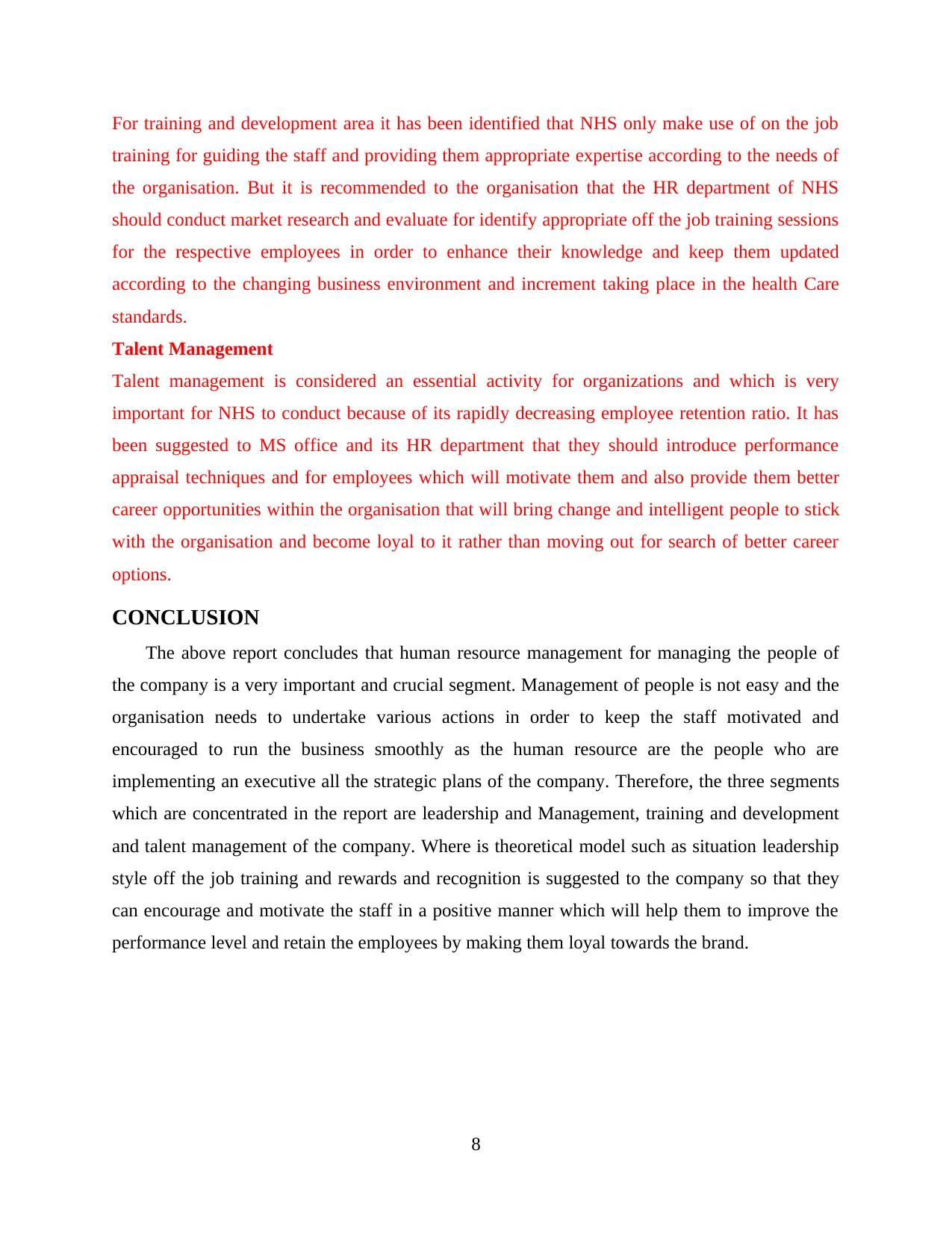
For training and development area it has been identified that NHS only make use of on the job
training for guiding the staff and providing them appropriate expertise according to the needs of
the organisation. But it is recommended to the organisation that the HR department of NHS
should conduct market research and evaluate for identify appropriate off the job training sessions
for the respective employees in order to enhance their knowledge and keep them updated
according to the changing business environment and increment taking place in the health Care
standards.
Talent Management
Talent management is considered an essential activity for organizations and which is very
important for NHS to conduct because of its rapidly decreasing employee retention ratio. It has
been suggested to MS office and its HR department that they should introduce performance
appraisal techniques and for employees which will motivate them and also provide them better
career opportunities within the organisation that will bring change and intelligent people to stick
with the organisation and become loyal to it rather than moving out for search of better career
options.
CONCLUSION
The above report concludes that human resource management for managing the people of
the company is a very important and crucial segment. Management of people is not easy and the
organisation needs to undertake various actions in order to keep the staff motivated and
encouraged to run the business smoothly as the human resource are the people who are
implementing an executive all the strategic plans of the company. Therefore, the three segments
which are concentrated in the report are leadership and Management, training and development
and talent management of the company. Where is theoretical model such as situation leadership
style off the job training and rewards and recognition is suggested to the company so that they
can encourage and motivate the staff in a positive manner which will help them to improve the
performance level and retain the employees by making them loyal towards the brand.
8
training for guiding the staff and providing them appropriate expertise according to the needs of
the organisation. But it is recommended to the organisation that the HR department of NHS
should conduct market research and evaluate for identify appropriate off the job training sessions
for the respective employees in order to enhance their knowledge and keep them updated
according to the changing business environment and increment taking place in the health Care
standards.
Talent Management
Talent management is considered an essential activity for organizations and which is very
important for NHS to conduct because of its rapidly decreasing employee retention ratio. It has
been suggested to MS office and its HR department that they should introduce performance
appraisal techniques and for employees which will motivate them and also provide them better
career opportunities within the organisation that will bring change and intelligent people to stick
with the organisation and become loyal to it rather than moving out for search of better career
options.
CONCLUSION
The above report concludes that human resource management for managing the people of
the company is a very important and crucial segment. Management of people is not easy and the
organisation needs to undertake various actions in order to keep the staff motivated and
encouraged to run the business smoothly as the human resource are the people who are
implementing an executive all the strategic plans of the company. Therefore, the three segments
which are concentrated in the report are leadership and Management, training and development
and talent management of the company. Where is theoretical model such as situation leadership
style off the job training and rewards and recognition is suggested to the company so that they
can encourage and motivate the staff in a positive manner which will help them to improve the
performance level and retain the employees by making them loyal towards the brand.
8
⊘ This is a preview!⊘
Do you want full access?
Subscribe today to unlock all pages.

Trusted by 1+ million students worldwide
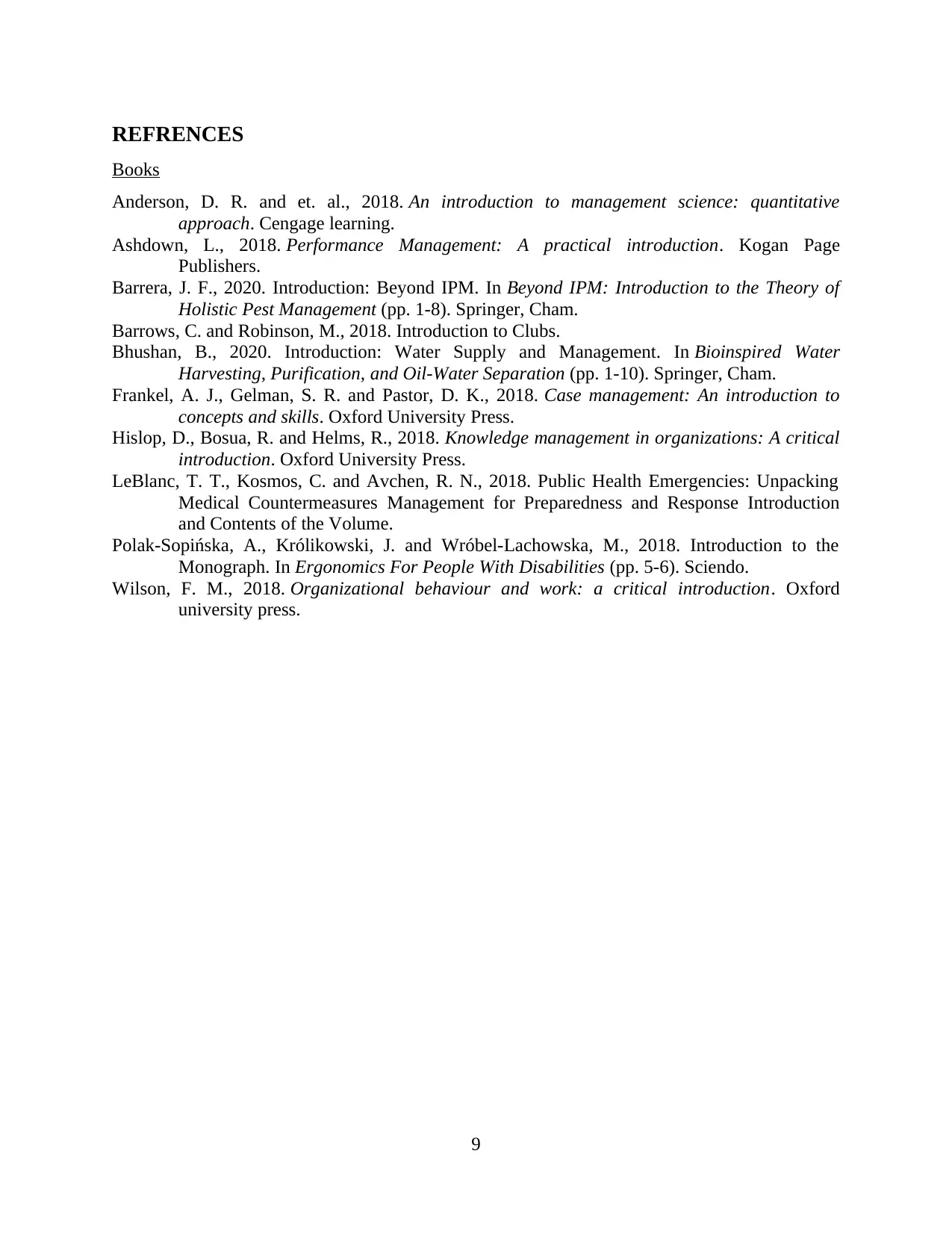
REFRENCES
Books
Anderson, D. R. and et. al., 2018. An introduction to management science: quantitative
approach. Cengage learning.
Ashdown, L., 2018. Performance Management: A practical introduction. Kogan Page
Publishers.
Barrera, J. F., 2020. Introduction: Beyond IPM. In Beyond IPM: Introduction to the Theory of
Holistic Pest Management (pp. 1-8). Springer, Cham.
Barrows, C. and Robinson, M., 2018. Introduction to Clubs.
Bhushan, B., 2020. Introduction: Water Supply and Management. In Bioinspired Water
Harvesting, Purification, and Oil-Water Separation (pp. 1-10). Springer, Cham.
Frankel, A. J., Gelman, S. R. and Pastor, D. K., 2018. Case management: An introduction to
concepts and skills. Oxford University Press.
Hislop, D., Bosua, R. and Helms, R., 2018. Knowledge management in organizations: A critical
introduction. Oxford University Press.
LeBlanc, T. T., Kosmos, C. and Avchen, R. N., 2018. Public Health Emergencies: Unpacking
Medical Countermeasures Management for Preparedness and Response Introduction
and Contents of the Volume.
Polak-Sopińska, A., Królikowski, J. and Wróbel-Lachowska, M., 2018. Introduction to the
Monograph. In Ergonomics For People With Disabilities (pp. 5-6). Sciendo.
Wilson, F. M., 2018. Organizational behaviour and work: a critical introduction. Oxford
university press.
9
Books
Anderson, D. R. and et. al., 2018. An introduction to management science: quantitative
approach. Cengage learning.
Ashdown, L., 2018. Performance Management: A practical introduction. Kogan Page
Publishers.
Barrera, J. F., 2020. Introduction: Beyond IPM. In Beyond IPM: Introduction to the Theory of
Holistic Pest Management (pp. 1-8). Springer, Cham.
Barrows, C. and Robinson, M., 2018. Introduction to Clubs.
Bhushan, B., 2020. Introduction: Water Supply and Management. In Bioinspired Water
Harvesting, Purification, and Oil-Water Separation (pp. 1-10). Springer, Cham.
Frankel, A. J., Gelman, S. R. and Pastor, D. K., 2018. Case management: An introduction to
concepts and skills. Oxford University Press.
Hislop, D., Bosua, R. and Helms, R., 2018. Knowledge management in organizations: A critical
introduction. Oxford University Press.
LeBlanc, T. T., Kosmos, C. and Avchen, R. N., 2018. Public Health Emergencies: Unpacking
Medical Countermeasures Management for Preparedness and Response Introduction
and Contents of the Volume.
Polak-Sopińska, A., Królikowski, J. and Wróbel-Lachowska, M., 2018. Introduction to the
Monograph. In Ergonomics For People With Disabilities (pp. 5-6). Sciendo.
Wilson, F. M., 2018. Organizational behaviour and work: a critical introduction. Oxford
university press.
9
1 out of 10
Related Documents
Your All-in-One AI-Powered Toolkit for Academic Success.
+13062052269
info@desklib.com
Available 24*7 on WhatsApp / Email
![[object Object]](/_next/static/media/star-bottom.7253800d.svg)
Unlock your academic potential
Copyright © 2020–2025 A2Z Services. All Rights Reserved. Developed and managed by ZUCOL.





